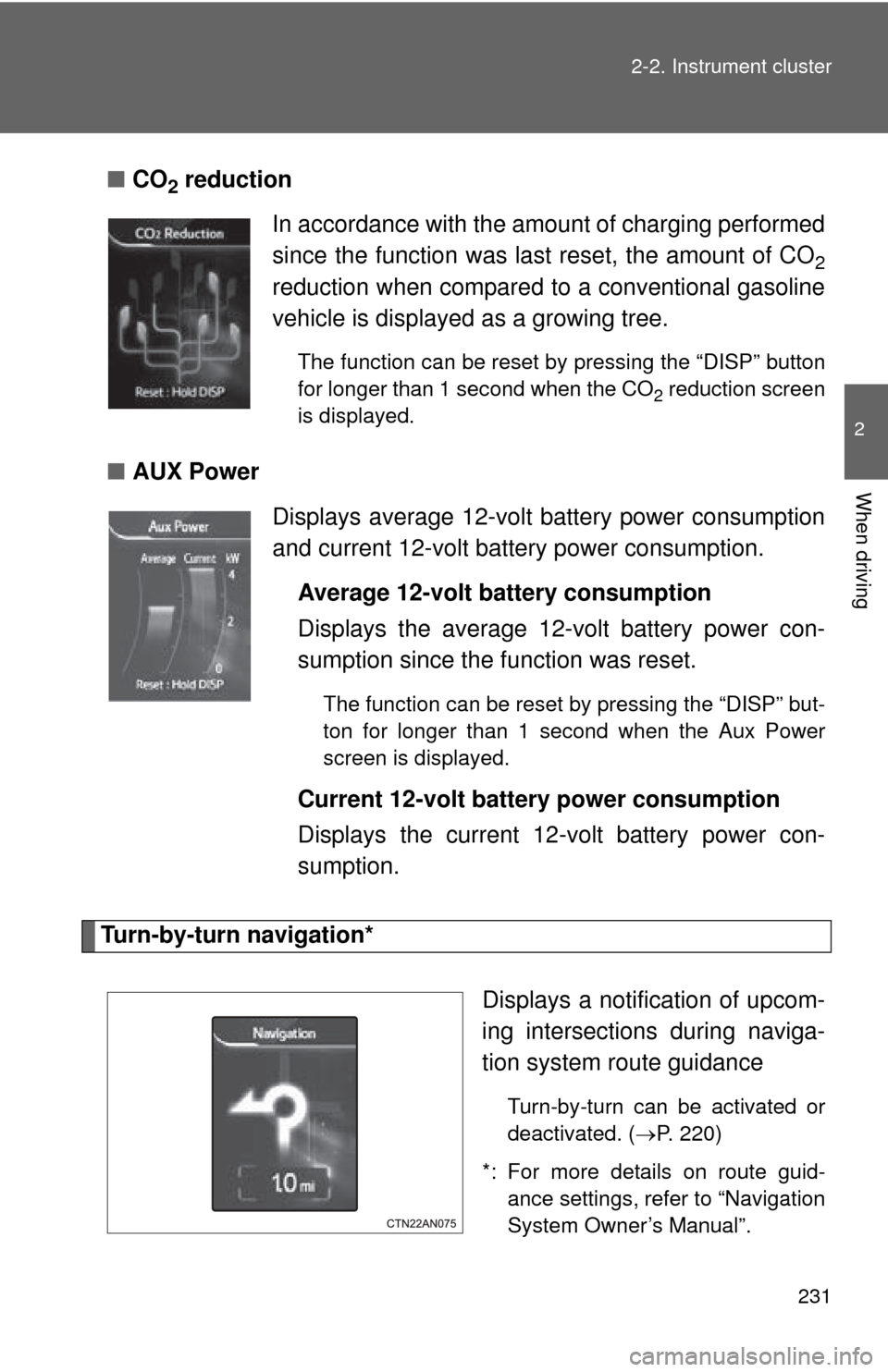Page 211 of 520

211
2-1. Driving procedures
2
When driving
■
Reverse warning buzzer
When shifting into R, a buzzer will sound to inform the driver that the shift
position is in R.
■ Automatically P position selection function
When the “POWER” switch is in ON mode while the shift position is in a
position other than P and the vehicle is stopped completely, pressing the
“POWER” switch will cause the automatic P position selection function to
operate together with the “POWER” switch being turned to off.
■ If the shift position cannot be shifted from P
There is a possibility that the 12-volt battery is discharged. Check the 12-volt
battery in this situation. ( P. 470)
■ Using regenerative braking
When shift position D or B is selected, releasing the accelerator pedal will
apply regenerative braking.
The vehicle can be accelerated even when shift position B is selected.
If the brake pedal is depressed very quickly after the accelerator pedal is
released, the amount of regenerated energy displayed on the EV system
indicator ( P. 221) may be less than expected. This is not a malfunction,
and will probably not feel any different than usual. The amount of regener-
ated energy will return to expected when the brake pedal is released and
depressed again.
■ If the system malfunctions
The following situations indicate a problem with the system.
Immediately stop the vehicle in a safe place and contact your Toyota dealer.
●All frames of the shift position indicators in the instrument cluster flash.
● The parking system error message appears on the multi-information dis-
play.
● The instrument cluster does not come on when the “POWER” switch is in
ON mode.
Page 218 of 520
218
2-2. Instrument cluster
Gauges and meters
The following gauges, meters and displays illuminate when the
“POWER” switch is in ON mode.EV System Indicator
Displays the EV system output or regeneration level.
SOC (State of Charge) gauge
Displays the amount of charge remaining in the traction battery.
Driving range
Displays an estimated drivable distance according to the climate setting
and the amount of charge remaining in the traction battery.
(P. 30, 276)
Speedometer
Displays the vehicle speed.
Multi-informat ion display
Presents the driver with a variety of driving-related data ( P. 227)
Page 221 of 520

221
2-2. Instrument cluster
2
When driving
■
The meters and display illuminate when
The “POWER” switch is in ON mode.
■ EV System Indicator
●By keeping the indicator needle within Eco area, more Eco-friendly driv-
ing can be achieved.
● Charge area indicates regeneration* status. Regenerated energy will be
used to charge the traction battery.
*: When used in this manual, “regeneration” refers to the conversion of energy created by the movement of the vehicle into electrical energy.
Power area
Shows that an Eco-friendly driving
range is being exceeded (during full
power driving etc.)
Eco area
Shows that the vehicle is being driven
in an Eco-friendly manner.
Charge area
Shows that energy is being recovered
via the regenerative charging.
Eco Driving Indicator
During Eco-friendly acceleration oper-
ation (Eco driving), Eco Driving Indica-
tor Light will turn on. When the
accelerator pedal is depressed exces-
sively, and when the vehicle is
stopped, the light turns off.
Eco Driving Indicator Light will not oper-
ate in the following conditions:
● The driving mode is set to SPORT
mode.
● The vehicle speed is approximately 80
mph (130 km/h) or higher.
Eco Driving Indicator Light can be acti-
vated or deactivated. ( P. 220)
Page 229 of 520
229
2-2. Instrument cluster
2
When driving
Trip information
■ Driving range
Displays an estimated driving range according to the
amount of charge remaining in the traction battery
and air conditioning settings.Displays what the estimated maximum driving
range is with the air conditioning system off
according to the amount of charge remaining in the
traction battery.
Displays the amount the estimated maximum driv-
ing range is shortened acco rding to current air con-
ditioning mode.
The climate setting is linked to the air conditioning sys-
tem, and changes according to air conditioning settings.
( P. 276)
The estimated maximum driving range is only an esti-
mate. According to driving conditions, the actual driving
range may differ. Keep early charging in mind.
The driving range according to current air conditioning
mode is displayed in the left section of the instrument
cluster. ( P. 218)
Page 231 of 520

231
2-2. Instrument cluster
2
When driving
■
CO2 reduction
■ AUX Power
Turn-by-turn navigation*
Displays a notification of upcom-
ing intersections during naviga-
tion system route guidance
Turn-by-turn can be activated or
deactivated. (P. 220)
*: For more details on route guid- ance settings, refer to “Navigation
System Owner’s Manual”.
In accordance with the amount of charging performed
since the function was last reset, the amount of CO
2
reduction when compared to a conventional gasoline
vehicle is displayed as a growing tree.
The function can be reset by pressing the “DISP” button
for longer than 1 second when the CO
2 reduction screen
is displayed.
Displays average 12-volt battery power consumption
and current 12-volt battery power consumption.
Average 12-volt battery consumption
Displays the average 12-volt battery power con-
sumption since the function was reset.
The function can be reset by pressing the “DISP” but-
ton for longer than 1 second when the Aux Power
screen is displayed.
Current 12-volt battery power consumption
Displays the current 12-volt battery power con-
sumption.
Page 237 of 520
237
2-3. Operating the lights and wipers
2
When driving
■
Automatic light off system
The headlights and tail lights turn off 30 seconds after driver’s door is
opened and closed if the “POWER” switch has been turned to ACCESSORY
mode or turned off. (The lights turn off immediately if on the key is
pressed twice after all the doors are closed.)
To turn the lights on again, turn the “POWER” switch to ON mode, or turn the
headlight switch off and then back to or .
■ Customization that can be co nfigured at Toyota dealer
Settings (e.g. light sensor sensitivity) can be deactivated.
(Customizable features P. 500)
NOTICE
■To prevent 12-volt battery discharge
Do not leave the lights on longer than necessary when the EV system is off.
Page 258 of 520
258
2-5. Driving information
Utility vehicle precautions
Utility vehicle feature● Specific design characteristics give it a higher center of gravity
than ordinary passenger cars. This vehicle design feature causes
this type of vehicle to be more likel y to rollover. And, utility vehicles
have a significantly higher rollover rate than other types of vehi-
cles.
● This vehicle is not designed for cornering at the same speeds as
ordinary passenger cars. Therefore, sharp turns at excessive
speeds may cause rollover.
● This vehicle is an electric vehi cle. It has a heavy traction battery
mounted under the floor, giving the vehicle a lower ground clear-
ance than that of conventional off-road vehicles. Avoid off-road
driving as it may damage the traction batteries.
This vehicle belongs to the utility vehicle class, which has higher
ground clearance and narrower tread in relation to the height of its
center of gravity as compared to ordinary passenger cars.
Page 259 of 520

259
2-5. Driving information
2
When driving
CAUTION
■
Utility vehicle precautions
Always observe the following precautions to minimize the risk of serious per-
sonal injury or damage to your vehicle:
●In a rollover crash, an unbelted person is significantly more likely to die
than a person wearing a seat belt. Therefore, the driver and all passengers
should fasten their seat belts whenever the vehicle is moving.
● Avoid sharp turns or abrupt maneuvers, if at all possible. Failure to operate
this vehicle correctly may result in loss of control or vehicle rollover caus-
ing death or serious injury.
● Avoid loading any items on the roof that will raise the vehicle’s center of
gravity.
● Always slow down in gusty crosswinds. Because of its profile and taller
vehicle height, this vehicle is more sensitive to side winds than an ordinary
passenger car. Slowing down will allow you to have better control.
● This vehicle is an electric vehicle. Avoid driving through deep water that
may cause the battery pack, motor or motor controller to be submerged or
flooded. Furthermore, this vehicle is not suitable for off-road driving, unlike
conventional sport utility vehicles. When it is unavoidable to drive off-road
or in rugged terrain, do not drive at excessive speeds, jump, make sharp
turns, strike objects, etc. This may cause loss of control or vehicle rollover
causing death or serious injury. You are also risking expensive damage to
your vehicle’s suspension, chassis and traction batteries.
● Do not drive horizontally across steep slopes. Driving straight up or
straight down is preferred. Your vehicle (or any similar vehicle) can tip over
sideways much more easily than forward or backward.